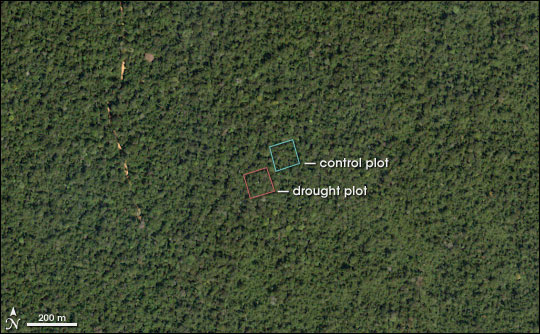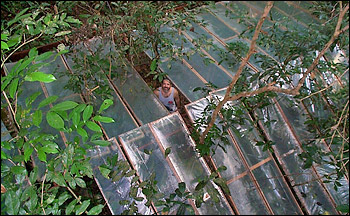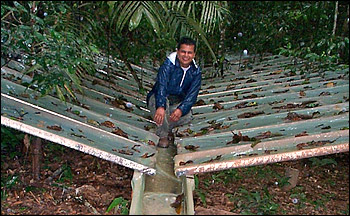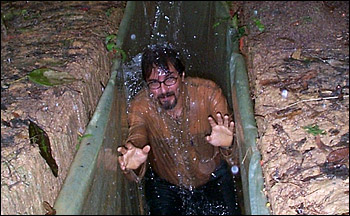

Stealing the Rain |
|||
While Asner was getting familiar with the new kinds of data coming from Hyperion, and designing and refining computer programs to process the observations and calculate the different vegetation indicators, Nepstad had located a suitable pair of sites in the Tapajós National Forest, a managed forest south of Santarem, Brazil, where the Tapajós River joins the Amazon. He was busy figuring out how to temporarily thwart Mother Nature. |
|||
 | |||
“I just love that kind of thing,” Nepstad says of the challenge of devising a plan to prevent rain from reaching the rainforest. “Challenging” doesn’t seem like a strong enough word to describe the situation. “We came up with panels—roofing plates that you can get at local hardware stores—suspended on a wooden structure [about one and a half to two meters off the ground] and tilted to run off into gutters. Each panel was half a meter by 3 meters, and there were 5,600 of them, made out of essentially clear, greenhouse plastic. Then there were 1,700 meters of gutters--a mile of gutter! All that flows into a trench around plot. The trench is lined with plastic, and the water flows off site into a gully about 300 meters away.” |
Scientists prevented rain from reaching the ground in one area (drought plot) and allowed rain to fall normally in another (control plot). Although the forest looks uniform from above, species diversity is so high that scientists had to survey 54 acres of tropical forest in order to find two, 2.5-acre plots with enough tree species in common for a good comparison. (Image by Robert Simmon, based on IKONOS data copyright Space Imaging) | ||
 |
The LBA team built a system of panels, gutters, and trenches to steal the rain from the Amazon Rainforest. Clear greenhouse plastic wrapped around wooden frames deflected rain as it fell ... | ||
 |
... into a network of gutters ... | ||
 |
... that drained into a narrow trench, which carried the water off the site. (Photographs courtesy Dan Nepstad) | ||
To minimize damage to the forest during construction, the 1- to 2-meter-deep trenches around the plot were dug by hand—all 1,500 meters of them. “Of course, as we dug them out, they became great congregating places for every kind of snake you can imagine, boa constrictors, everything,” says Nepstad with a short laugh. |
|||
Snakes weren’t the only animal visitors. “With the volume of wood and other materials we were bringing in with trucks, we quickly created lakes in the road, and pretty soon we started seeing eyes in them.” The eyes belonged to caiman, a kind of crocodile. “A number of times the workers would be hauling wheelbarrows of dirt from the trenches out to a pile, and find jaguars sitting on the dirt pile, staring at them.” “In all we probably brought in a volume of wood equal to about thirty percent of what was there in the forest itself. I would say about 100 tons of wood was brought in from local, legal,” he stresses, “saw mills. The people who were bringing in all this wood thought we were crazy.” Aside from the trenches they dug to divert water from the site, they also had to dig out 11-meter pits so that they could measure soil moisture at various depths throughout the course of the experiment. “It took three people six weeks to dig each pit, and there were ten of them. At the height of the construction, we had about 45 people employed at the site, and it took about a year and half to set it all up.” The team spent about a year establishing a set of baseline measurements for 12 characteristics in each plot: rainfall, soil moisture, pre-dawn and mid-day leaf water potential (indicates water stress), litterfall (leaves, twigs, flowers, etc, dropped from the trees to the ground), litter decomposition, leaf area and canopy openness, photosynthesis, flower and fruit production, stem growth, stem respiration (the release of carbon dioxide back into the atmosphere as the tree consumes the sugars and starches it creates during photosynthesis), gases emitted from the soil, and solution chemistry (the different kinds of chemicals that leach into rainwater as it drips down through forest and onto the ground). |
 Prolific native wildlife frequently crawled in and out of the study area. This caiman may look threatening, but it’s only about 30 centimeters (12 inches) long. (Photograph courtesy Paul Lefebvre) | ||